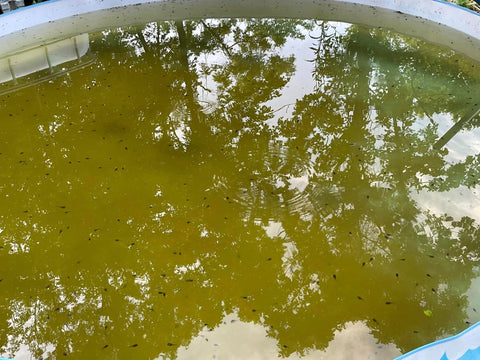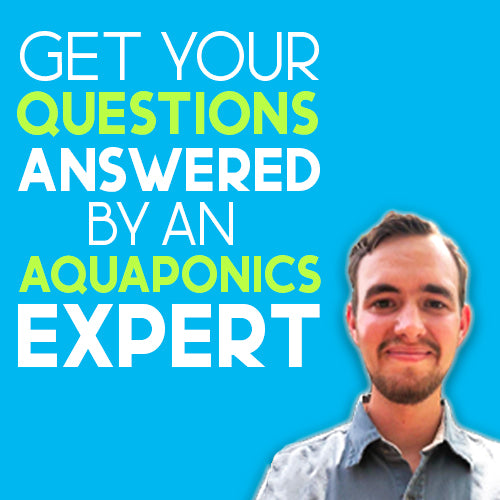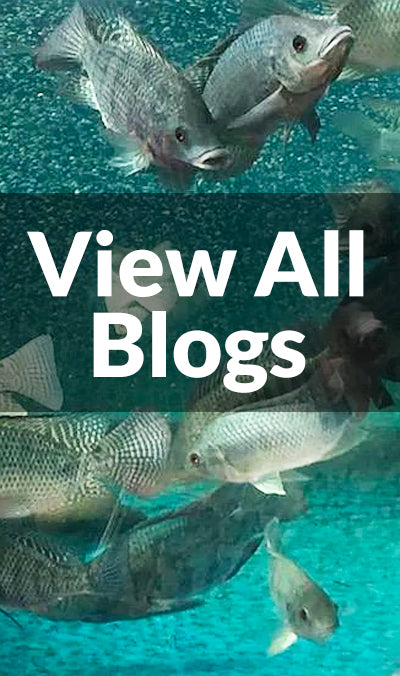Transitioning fingerlings into your aquaponic system is a process that can significantly impact the health and success of your entire setup. As the lifeblood of your aquaponics systems, these juvenile fish require careful attention and consideration during the integration process. From ensuring the optimal water conditions to providing proper nutrition and monitoring their well-being, there are several factors to address for a smooth transition.
This article will delve into essential tips and techniques to help you seamlessly introduce fingerlings into your aquaponic system. Whether you're an aquaponics beginner or a seasoned practitioner looking to refine your methods, this guide will provide valuable insights to enhance the transition process and maximize the productivity of your system.
The Importance of Proper Fingerling Transition
Properly transitioning fingerlings, or juvenile fish, into your aquaponics system is crucial for its overall success. Fingerlings are delicate and sensitive to changes in their environment, and a smooth transition is essential to minimize stress and ensure their health and growth. The initial stages of their introduction set the foundation for their well-being throughout their lifecycle in the system. A carefully managed transition not only promotes the health and vitality of the fingerlings but also contributes to the overall stability and productivity of your ecosystem.
Understanding Fingerlings
Fingerlings are juvenile fish typically between the stages of larval and adult fish. They are characterized by their small size, usually ranging from a few millimeters to a few inches in length, depending on the species. Fingerlings are at a critical developmental stage where they are still growing rapidly and are highly vulnerable to changes in their environment. They require specific care and attention to ensure their survival and healthy growth within an aquaponics system.

The Common Types of Fingerlings Used in Aquaponics
- Tilapia: Tilapia is one of the most common fish species used in aquaponics due to its fast growth rate, tolerance to a wide range of water conditions, and ability to thrive in captivity. Nile tilapia (Oreochromis niloticus) and Mozambique tilapia (Oreochromis mossambicus) are popular choices for aquaponic systems.
- Trout: Trout species such as rainbow trout (Oncorhynchus mykiss) and brook trout (Salvelinus fontinalis) are favored in cooler climates and are known for their delicious taste and rapid growth under the right conditions.
- Catfish: Channel catfish (Ictalurus punctatus) and other catfish species are well-suited for aquaponics, particularly in warmer climates. They are hardy, fast-growing, and can tolerate a wide range of water conditions.
- Carp: Common carp (Cyprinus carpio) and other carp species are often used in aquaponics systems, especially in regions where they are native or commonly farmed. They are resilient fish with a high tolerance for variable water conditions.
- Other species: Depending on the geographical location and specific requirements of the aquaponics system, other fish species such as perch, bass, and ornamental fish like koi and goldfish may also be used as fingerlings.
Factors to Consider When Selecting Fingerlings for Your System
- Water temperature: Different fish species have specific temperature requirements for optimal growth and health. Select fingerlings that are well-suited to the temperature range of your aquaponics system.
- Water quality: Consider the water quality parameters such as pH,ammonia, nitrite, and nitrate levels, that are suitable for the chosen fish species. Ensure that your system can maintain these parameters within the desired range.
- Growth rate: Choose fingerlings with a growth rate that aligns with your production goals and timeline. Some species grow faster than others and may be more suitable for short-term or long-term production.
- Dietary preferences: Understand the dietary requirements of the selected fish species and ensure that your aquaponics system can provide appropriate feed to support their growth and nutrition.
- Legal regulations: Be aware of any regulations or restrictions related to the stocking and cultivation of fish species in your area. Obtain necessary permits and comply with local laws governing aquaculture and aquaponics.
Preparing Your Aquaponics System
A. Water Quality Parameters
1. pH Levels:
- pH levels in aquaponics systems should typically range between 6.8 to 7.2 to maintain optimal conditions for both fish and plants.
- Test and adjust pH levels using appropriate buffers or additives to ensure stability within the desired range.
- Fluctuations in pH can stress fish and affect nutrient availability for plants, so regular monitoring is essential.
2. Ammonia, Nitrite, and Nitrate Levels:
- Ammonia, nitrite, and nitrate are byproducts of fish waste and decomposing organic matter in the aquaponics system.
- Ammonia and nitrite are toxic to fish at high levels, so it's crucial to maintain low concentrations through biological filtration and water changes.
- Nitrate, while less toxic, should be monitored and kept at levels suitable for plant growth without compromising fish health.
3. Temperature Considerations:
- Fish species have specific temperature requirements for optimal growth and metabolic function.
- Ensure that the water temperature remains within the preferred range for the selected fish species.
- Use heaters or chillers to regulate water temperature as needed, especially in climates with extreme temperature fluctuations.
B. Ensuring Adequate Filtration and Aeration
- Proper filtration is essential for removing solid waste and maintaining water quality in the aquaponics system.
- Incorporate biological filter media such as bio balls, ceramic rings, or sponge filters to provide ample surface area for beneficial bacteria colonization.
- Aeration is crucial for oxygenating the water and ensuring adequate oxygen levels for fish respiration and beneficial bacterial activity.
- Use air stones, diffusers, or surface agitation methods such as waterfalls or splashing to promote gas exchange and maintain dissolved oxygen levels.
C. Adjusting System Parameters to Accommodate New Inhabitants
- Before introducing fingerlings into the aquaponics system, ensure that all system parameters are optimized and stable.
- Monitor water quality parameters closely during the initial weeks after adding fingerlings to detect any fluctuations or imbalances.
- Adjust feeding rates, water flow rates, and other system parameters as needed to accommodate the increased bio-load and nutrient demand from the new inhabitants.
- Gradually acclimate fingerlings to the system's environment to minimize stress and allow them to adjust to their new surroundings more effectively.

Acclimating Fingerlings
A. Importance of Gradual Acclimation:
- Gradual acclimation is crucial for helping fingerlings adjust to their new water conditions without experiencing shock or stress.
- Sudden changes in temperature, pH, or water chemistry can be harmful to fish and may lead to health issues or even mortality.
- By gradually introducing fingerlings to the aquaponics system's water parameters, you can minimize stress and increase their chances of successful adaptation.
B. Methods for Acclimating Fingerlings to New Water Conditions:
1. Drip Acclimation:
- Drip acclimation involves slowly adding water from the aquaponics system to the container holding the fingerlings over an extended period.
- This method allows the fingerlings to gradually adjust to differences in water chemistry, temperature, and pH without sudden changes.
- Use a drip line or air hose to regulate the flow of water into the container, ensuring a steady drip rate.
- Continue dripping water until the volume of water in the container has doubled or tripled, indicating that the fingerlings have been adequately acclimated.
2. Floating Bag Method:
- In the floating bag method, the fingerlings are placed in a plastic bag or container filled with water from their original source.
- Float the bag or container in the aquaponics system's water, allowing the temperature to equalize gradually.
- Slowly add small amounts of water from the aquaponics system into the bag or container to slowly acclimate the fingerlings to the new water conditions.
- Once the temperature and water parameters are balanced, release the fingerlings into the aquaponics system.
3. Temperature Adjustment Techniques:
- Temperature adjustment techniques involve gradually matching the temperature of the water in the container holding the fingerlings with that of the aquaponics system.
- Use a thermometer to monitor and adjust the water temperature in the container as needed.
- If the temperature difference between the container and the aquaponics system is significant, slowly add small amounts of water from the system to the container to raise or lower the temperature.
C. Monitoring Stress Levels During Acclimation Process:
- Monitor fingerlings closely during the acclimation process for signs of stress or distress, such as erratic swimming behavior, loss of appetite, or increased aggression.
- If stress symptoms are observed, adjust the acclimation process accordingly by slowing down the rate of water exchange or providing temporary shelter for the fingerlings.
- Gradually acclimate fingerlings over a period of several hours to ensure that they have adequate time to adjust to the new water conditions without experiencing undue stress.
- After acclimation, continue monitoring fingerlings closely in the aquaponics system to ensure they are adapting well and exhibiting normal behavior.
Fingerling Nutrition and Feeding
A. Understanding Fingerling Dietary Needs:
- Fingerlings have specific dietary requirements based on their species, size, and developmental stage.
- They require a balanced diet that provides essential nutrients such as protein, carbohydrates, fats, vitamins, and minerals for healthy growth and development.
- Research the dietary preferences and nutritional requirements of the fish species you are cultivating to ensure they receive adequate nutrition in the aquaponics system.
B. Selecting Appropriate Feed for Fingerlings:
- Choose high-quality, species-specific feed formulated specifically for fingerlings.
- Consider factors such as pellet size, protein content, and nutrient composition when selecting feed for your fingerlings.
- Opt for feeds that promote rapid growth, good digestion, and overall health while minimizing waste and environmental impact.
C. Establishing a Feeding Regimen:
- Develop a feeding regimen that meets the nutritional needs of your fingerlings while minimizing excess feed and waste.
- Feed fingerlings multiple times a day in small, controlled portions rather than a single large feeding to prevent overfeeding and water quality issues.
- Monitor the growth and feeding behavior of your fingerlings to determine the appropriate feeding frequency and portion size.
- Adjust the feeding regimen as needed based on factors such as water temperature, fish growth rates, and nutrient uptake by plants.
D. Monitoring Feeding Behavior and Adjusting as Necessary:
- Observe the feeding behavior of your fingerlings to ensure they are actively consuming the feed.
- Monitor for signs of underfeeding or overfeeding, such as fish hovering near the surface or bottom of the tank, reluctance to feed, or uneaten feed accumulating in the water.
- Adjust the feeding regimen based on observed feeding behavior and growth rates to optimize nutrient intake and minimize waste.
- Regularly assess the condition and health of your fingerlings to ensure they are receiving adequate nutrition and thriving in the aquaponics system.
- Work with a qualified nutritionist or aquaculture expert to develop a customized feeding plan tailored to the specific needs of your fingerlings and aquaponics system.

Fingerling Health and Disease Prevention
A. Importance of Maintaining a Clean and Healthy Environment:
- A clean and healthy environment is essential for the well-being and productivity of fingerlings in an aquaponics system.
- Poor water quality, excess waste buildup, and inadequate filtration can lead to stress, disease outbreaks, and reduced growth rates among fingerlings.
- Regular maintenance tasks such as water quality testing, tank cleaning, and filter maintenance are necessary to maintain optimal water conditions and prevent health issues.
B. Monitoring and Maintenance
1. Regular Water Quality Testing and Monitoring:
- Conduct regular water quality testing to monitor key parameters such as pH, ammonia, nitrite, nitrate, dissolved oxygen, and temperature.
- Use test kits or electronic monitoring devices to measure water quality parameters accurately and reliably.
- Keep detailed records of water quality measurements over time to track trends, identify potential issues, and make informed management decisions.
- Adjust water quality parameters as needed to maintain optimal conditions for fingerlings and plant growth in the aquaponics system.
2. Observing Fingerling Behavior and Growth Rates:
- Monitor fingerling behavior and growth rates regularly to assess their health, well-being, and development.
- Observe feeding behavior, swimming patterns, and interactions among fingerlings to detect any signs of stress, aggression, or abnormal behavior.
- Measure and record fingerling growth rates periodically to track their progress and adjust feeding rates and nutrient levels accordingly.
- Note any deviations from normal behavior or growth patterns and investigate potential causes to address underlying issues promptly.
C. Performing Routine System Maintenance Tasks:
- Establish a schedule for routine system maintenance tasks to keep the aquaponics system operating smoothly and efficiently.
- Clean and maintain filtration systems, including mechanical and biological filters, to ensure optimal water quality and nutrient cycling.
- Remove excess waste, uneaten feed, and debris from the system regularly to prevent fouling and maintain a clean environment for fingerlings.
- Inspect equipment, such as pumps, air stones, and plumbing, for signs of wear, damage, or malfunction and repair or replace as needed.
- Regularly check and maintain water levels, oxygenation systems, and temperature control devices to prevent fluctuations that could stress fingerlings.
Conclusion
The successful transition of fingerlings into your aquaponics system requires careful attention to various factors, from water quality management to feeding practices and disease prevention. By understanding the specific needs of your fingerlings and implementing proper acclimation techniques, you can minimize stress and promote their health and growth within the system. Additionally, establishing a proactive approach to troubleshooting common problems such as poor water quality, stress, and disease outbreaks can help maintain the stability and productivity of your aquaponics system. With dedication, diligence, and ongoing learning, you can create a thriving aquaponics ecosystem that sustains both fish and plants while providing fresh, nutritious food for years to come.






Leave a comment (all fields required)